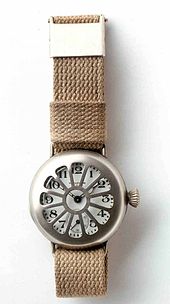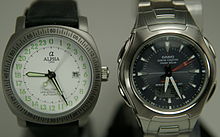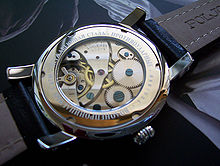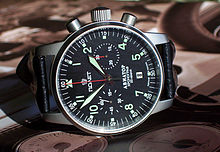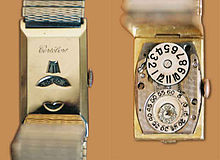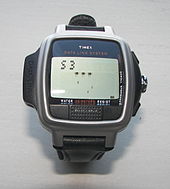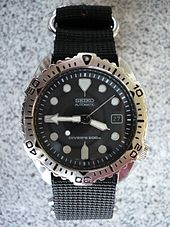- Watch
-
For other uses, see Watch (disambiguation).
A watch is a small timepiece, typically worn either on the wrist or attached on a chain and carried in a pocket, with wristwatches being the most common type of watch used today. They evolved in the 17th century from spring powered clocks, which appeared in the 15th century. The first watches were strictly mechanical. As technology progressed, the mechanisms used to measure time have, in some cases, been replaced by use of quartz vibrations or electromagnetic pulses and are called quartz movements.[1] The first digital electronic watch was developed in 1970.[2]
Before wristwatches became popular in the 1920s, most watches were pocket watches, which often had covers and were carried in a pocket and attached to a watch chain or watch fob.[3] In early 1900s, the wristwatch, originally called a Wristlet, was reserved for women and considered more of a passing fad than a serious timepiece. Real gentlemen, who carried pocket watches, were actually quoted as saying they would "sooner wear a skirt as wear a wristwatch".[citation needed] This all changed in World War I when soldiers on the battlefield found using a pocket watch to be impractical, so they attached the pocket watch to their wrist by a cupped leather strap. It is also believed that Girard-Perregaux equipped the German Imperial Navy in a similar fashion as early as the 1880s, which were used while synchronizing naval attacks and firing artillery.[4]
Most inexpensive and medium-priced watches used mainly for timekeeping are electronic watches with quartz movements.[1] Expensive, collectible watches valued more for their workmanship and aesthetic appeal than for simple timekeeping, often have purely mechanical movements and are powered by springs, even though mechanical movements are less accurate than more affordable quartz movements. In addition to the time, modern watches often display the day, date, month and year, and electronic watches may have many other functions. Watches that provide additional time-related features such as timers, chronographs and alarm functions are not uncommon. Some modern designs even go as far as using GPS technology or heart-rate monitoring capabilities.
Contents
History
Main article: History of watchesSee also: History of timekeeping devicesMovement
A movement in watchmaking is the mechanism that measures the passage of time and displays the current time (and possibly other information including date, month and day). Movements may be entirely mechanical, entirely electronic (potentially with no moving parts), or a blend of the two. Most watches intended mainly for timekeeping today have electronic movements, with mechanical hands on the watch face indicating the time.
Mechanical movements
Main article: Mechanical watchCompared to electronic movements, mechanical watches are less accurate, often with errors of seconds per day, and they are sensitive to position, temperature[5] and magnetism.[6] They are also costly to produce, require regular maintenance and adjustment, and are more prone to failure. Nevertheless, the craftsmanship of mechanical watches still attracts interest from part of the watch-buying public. Skeleton watches are designed to leave the mechanism visible for aesthetic purposes.
Mechanical movements use an escapement mechanism to control and limit the unwinding and winding parts of a spring, converting what would otherwise be a simple unwinding into a controlled and periodic energy release. Mechanical movements also use a balance wheel together with the balance spring (also known as a hairspring) to control motion of the gear system of the watch in a manner analogous to the pendulum of a pendulum clock. The tourbillon, an optional part for mechanical movements, is a rotating frame for the escapement, which is used to cancel out or reduce the effects of gravitational bias to the timekeeping. Due to the complexity of designing a tourbillon, they are very expensive, and only found in "prestige" watches.[citation needed]
The pin-lever escapement (called the Roskopf movement after its inventor, Georges Frederic Roskopf), which is a cheaper version of the fully levered movement, was manufactured in huge quantities by many Swiss manufacturers as well as Timex, until it was replaced by quartz movements.[7][8][9]
Tuning-fork watches use a type of electromechanical movement. Introduced by Bulova in 1960, they use a tuning fork with a precise frequency (most often 360 hertz) to drive a mechanical watch. The task of converting electronically pulsed fork vibration into rotary movement is done via two tiny jeweled fingers, called pawls. Tuning-fork watches were rendered obsolete when electronic quartz watches were developed, because quartz watches were cheaper to produce and even more accurate.[citation needed]
Main article: MainspringTraditional mechanical watch movements use a spiral spring called a mainspring as a power source. In manual watches the spring must be rewound periodically by the user by turning the watch crown. Antique pocketwatches were wound by inserting a separate key into a hole in the back of the watch and turning it. Most modern watches are designed to run 40 hours on a winding and thus must be wound daily, but some run for several days and a few have 192-hour mainsprings and are wound weekly.
Main article: Automatic watch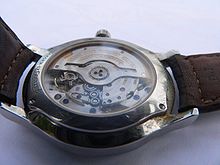 Automatic watch: An eccentric weight, called a rotor, swings with the movement of the wearer's body and winds the spring
Automatic watch: An eccentric weight, called a rotor, swings with the movement of the wearer's body and winds the spring
A self-winding or automatic watches is one that rewinds the mainspring of a mechanical movement by the natural motions of the wearer's body. The first self-winding mechanism was invented for pocketwatches in 1770 by Abraham-Louis Perrelet,[10] but the first "self-winding", or "automatic", wristwatch was the invention of a British watch repairer named John Harwood in 1923. This type of watch allows for constant winding without special action from the wearer; it works by an eccentric weight, called a winding rotor, which rotates with the movement of the wearer's wrist. The back-and-forth motion of the winding rotor couples to a ratchet to automatically wind the mainspring. Self-winding watches usually can also be wound manually so they can be kept running when not worn or if the wearer's wrist motions are inadequate to keep the watch wound.
Electronic movements
See also: Electric watchElectronic movements have few or no moving parts, as they use the piezoelectric effect in a tiny quartz crystal to provide a stable time base for a mostly electronic movement. The crystal forms a quartz oscillator which resonates at a specific and highly stable frequency, and which can be used to accurately pace a timekeeping mechanism. For this reason, electronic watches are often called quartz watches. Most quartz movements are primarily electronic but are geared to drive mechanical hands on the face of the watch in order to provide a traditional analog display of the time, which is still preferred by some consumers.
 Prototype of a Quartz Wristwatch, CEH Switzerland, 1967
Prototype of a Quartz Wristwatch, CEH Switzerland, 1967
In 1959 Seiko gave an order to Epson (a daughter company of Seiko and the actual brain behind the quartz revolution) to start developing a quartz wristwatch. The project was codenamed 59A and by the 1964 Tokyo Summer Olympics, Seiko had a working prototype of a portable quartz watch which took part in time measurements throughout the event.
The first prototypes of an electronic quartz wristwatch (not just portable quartz watches as the Seiko timekeeping devices at the Tokyo Olympics in 1964) were made by the CEH research laboratory in Neuchâtel, Switzerland. From 1965 through 1967 pioneering development work was done on a miniaturized 8192 Hz quartz oscillator, a thermo-compensation module and an inhouse-made, dedicated integrated circuit (unlike the hybrid circuits used in the later Seiko Astron wristwatch). As a result, the BETA 1 prototype set new timekeeping performance records at the International Chronometric Competition held at the Observatory of Neuchâtel in 1967.[11]
The first quartz watch to enter production was the Seiko 35 SQ Astron, which hit the shelves on December 25, 1969. One particularly interesting decision made by Seiko at that time was to not patent the whole movement of the quartz wristwatch, thus allowing other manufacturers to benefit from the Seiko technology. This played a major role in the popularity and quick development of the quartz watch, which in less than a decade was dominant in the watch market, nearly ending an almost 100 years of mechanical wristwatch heritage. The modern quartz movements are produced in very large quantities, and even the cheapest wristwatches typically have quartz movements. Whereas mechanical movements can typically be off by several seconds a day, an inexpensive quartz movement in a child's wristwatch may still be accurate to within half a second per day—ten times better than a mechanical movement.[12]
After a consolidation of the mechanical watch industry in Switzerland during the 1970s, mass production of quartz wristwatches took off under the leadership of the Swatch Group of companies, a Swiss conglomerate with vertical control of the production of Swiss watches and related products. For quartz wristwatches, subsidiaries of Swatch manufactured watch batteries (Renata), oscillators (Oscilloquartz) and integrated circuits (Ebauches Electronic SA). The launch of the new SWATCH brand in 1983, was marked by bold new styling, design and marketing. Today, the Swatch Group is the world's largest watch company.
Seiko's efforts to combine the quartz and mechanical movements bore fruit after 20 years of research, leading to the introduction of the Seiko Spring Drive, first in a limited domestic market production in 1999 and to the world in September 2005. The Spring Drive manages to keep time within quartz standards without the use of a battery, using a traditional mechanical gear train powered by a spring, while at the same time doesn't have the need of a balance wheel either.
Radio time signal watches are a type of electronic quartz watch which synchronizes (time transfer) its time with an external time source such as in atomic clocks, time signals from GPS navigation satellites, the German DCF77 signal in Europe, WWVB in the US, and others. Movements of this type may -among others- synchronize not only the time of day but also the date, the leap-year status of the current year, and the current state of daylight saving time (on or off). However, other than the radio receiver these watches are normal quartz watches in all other aspects.
Electronic watches require electricity as a power source. Some mechanical movements and hybrid electronic-mechanical movements also require electricity. Usually the electricity is provided by a replaceable battery. The first use of electrical power in watches was as a substitute for the mainspring, in order to remove the need for winding. The first electrically powered watch, the Hamilton Electric 500, was released in 1957 by the Hamilton Watch Company of Lancaster, Pennsylvania.
Watch batteries (strictly speaking cells, as a battery is composed of multiple cells) are specially designed for their purpose. They are very small and provide tiny amounts of power continuously for very long periods (several years or more). In most cases, replacing the battery requires a trip to a watch-repair shop or watch dealer; this is especially true for watches that are designed to be water-resistant, as special tools and procedures are required to ensure that the watch remains water-resistant after battery replacement. Silver-oxide and lithium batteries are popular today; mercury batteries, formerly quite common, are no longer used, for environmental reasons. Cheap batteries may be alkaline, of the same size as silver-oxide cells but providing shorter life. Rechargeable batteries are used in some solar powered watches.
Some electronic watches are also powered by the movement of the wearer of the watch. For instance, Seiko's Kinetic powered quartz watches make use of the motion of the wearer's arm turning a rotating weight which causes a tiny generator to supply power to charge a rechargeable battery that runs the watch. The concept is similar to that of self-winding spring movements, except that electrical power is generated instead of mechanical spring tension.
Solar powered watches are powered by light. A photovoltaic cell on the face (dial) of the watch converts light to electricity, which in turn is used to charge a rechargeable battery or capacitor. The movement of the watch draws its power from the rechargeable battery or capacitor. As long as the watch is regularly exposed to fairly strong light (such as sunlight), it never needs battery replacement, and some models need only a few minutes of sunlight to provide weeks of energy (as in the Citizen Eco-Drive). Some of the early solar watches of the 1970s had innovative and unique designs to accommodate the array of solar cells needed to power them (Synchronar, Nepro, Sicura and some models by Cristalonic, Alba, Seiko and Citizen). As the decades progressed and the efficiency of the solar cells increased while the power requirements of the movement and display decreased, solar watches began to be designed to look like other conventional watches.[13]
A rarely used power source is the temperature difference between the wearer's arm and the surrounding environment (as applied in the Citizen Eco-Drive Thermo).
Display
Analog
Traditionally, watches have displayed the time in analog form, with a numbered dial upon which are mounted at least a rotating hour hand and a longer, rotating minute hand. Many watches also incorporate a third hand that shows the current second of the current minute. Watches powered by quartz usually have a second hand that snaps every second to the next marker. Watches powered by a mechanical movement have a "sweep second hand", the name deriving from its uninterrupted smooth (sweeping) movement across the markers, although this is actually a misnomer in most cases; the hand merely moves in smaller steps, typically 1/5 of a second, corresponding to the beat (half period) of the balance wheel. In some escapements (for example the duplex escapement), the hand advances every two beats (full period) of the balance wheel, typically 1/2 second in those watches, or even every four beats (two periods, 1 second), in the double duplex escapement. A truly sweeping second hand is achieved with the tri-synchro regulator of Spring Drive watches. All of the hands are normally mechanical, physically rotating on the dial, although a few watches have been produced with "hands" that are simulated by a liquid-crystal display.
Analog display of the time is nearly universal in watches sold as jewelry or collectibles, and in these watches, the range of different styles of hands, numbers, and other aspects of the analog dial is very broad. In watches sold for timekeeping, analog display remains very popular, as many people find it easier to read than digital display; but in timekeeping watches the emphasis is on clarity and accurate reading of the time under all conditions (clearly marked digits, easily visible hands, large watch faces, etc.). They are specifically designed for the left wrist with the stem (the knob used for changing the time) on the right side of the watch; this makes it easy to change the time without removing the watch from the wrist. This is the case if one is right-handed and the watch is worn on the left wrist (as is traditionally done). If one is left-handed and wears the watch on the right wrist, one has to remove the watch from the wrist to reset the time or to wind the watch.
Analog watches as well as clocks are often marketed showing a display time of approximately 10:09 or 10:10. This creates a visually pleasing smile-like face on upper half of the watch, in addition to enclosing the manufacturer's name. Digital displays often show a time of 12:08, where the increases in the numbers from left to right culminating in the fully lit numerical display of the 8 also gives a positive feeling.[14][15]
Analog watch displays can be used to indicate cardinal direction due to the relation between the position of the hour hand and the position of the Sun in the sky. By rotating the watch so that the hour hand points toward the Sun, the point halfway between the hour hand and 12 o'clock will indicate south when observing from a position in the Northern hemisphere. In the Southern hemisphere, the point halfway between the hour hand pointed at the sun and 12 o'clock on the dial indicates North.
Digital
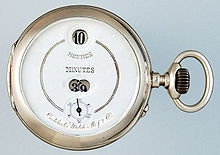 Cortébert digital mechanical pocket watch. 1890s
Cortébert digital mechanical pocket watch. 1890s
A digital display simply shows the time as a number, e.g., 12:08 instead of a short hand pointing towards the number 12 and a long hand 8/60 of the way round the dial. The digits are usually shown as a seven-segment display.
The first digital mechanical pocket watches appeared in late 19th century. In the 1920s the first digital mechanical wristwatches appeared.
The first digital electronic watch, a Pulsar LED prototype in 1970, was developed jointly by Hamilton Watch Company and Electro-Data. John Bergey, the head of Hamilton's Pulsar division, said that he was inspired to make a digital timepiece by the then-futuristic digital clock that Hamilton themselves made for the 1968 science fiction film 2001: A Space Odyssey. On April 4, 1972, the Pulsar was finally ready, made in 18-carat gold and sold for $2,100. It had a red light-emitting diode (LED) display.
Digital LED watches were very expensive and out of reach to the common consumer until 1975, when Texas Instruments started to mass produce LED watches inside a plastic case. These watches, which first retailed for only $20,[16] reduced to $10 in 1976, saw Pulsar lose $6 million and the Pulsar brand sold to Seiko.
Most watches with LED displays required that the user press a button to see the time displayed for a few seconds, because LEDs used so much power that they could not be kept operating continuously. Usually the LED display color would be red. Watches with LED displays were popular for a few years, but soon the LED displays were superseded by liquid crystal displays (LCDs), which used less battery power and were much more convenient in use, with the display always visible and no need to push a button before seeing the time. The first LCD watch with a six-digit LCD was the 1973 Seiko 06LC, although various forms of early LCD watches with a four-digit display were marketed as early as 1972 including the 1972 Gruen Teletime LCD Watch, and the Cox Electronic Systems Quarza.[17] In Switzerland, Ebauches Electronic SA presented a prototype eight-digit LCD wristwatch showing time and date at the MUBA Fair, Basle, in March 1973, using a Twisted Nematic LCD manufactured by Brown, Boveri & Cie, Switzerland, which became the supplier of LCDs to Casio for the CASIOTRON watch in 1974.[18]
From the 1980s onward, digital watch technology vastly improved. In 1982 Seiko produced a watch with a small television screen built in, and Casio produced a digital watch with a thermometer as well as another that could translate 1,500 Japanese words into English. In 1985, Casio produced the CFX-400 scientific calculator watch. In 1987 Casio produced a watch that could dial your telephone number and Citizen revealed one that would react to your voice. In 1995 Timex released a watch which allowed the wearer to download and store data from a computer to his wrist. Some watches, such as the Timex Datalink USB, feature dot matrix displays. Since their apex during the late 1980s to mid 1990s high technology fad, digital watches have mostly become simpler, less expensive time pieces with little variety between models.
Despite these many advances, almost all watches with digital displays are used as timekeeping watches. Expensive watches for collectors rarely have digital displays since there is little demand for them. Less craftsmanship is required to make a digital watch face and most collectors find that analog dials (especially with complications) vary in quality more than digital dials due to the details and finishing of the parts that make up the dial (thus making the differences between a cheap and expensive watch more evident).
Functions
All watches provide the time of day, giving at least the hour and minute, and usually the second. Most also provide the current date, and often the day of the week as well. However, many watches also provide a great deal of information beyond the basics of time and date. Some watches include alarms. Other elaborate and more expensive watches, both pocket and wrist models, also incorporate striking mechanisms or repeater functions, so that the wearer could learn the time by the sound emanating from the watch. This announcement or striking feature is an essential characteristic of true clocks and distinguishes such watches from ordinary timepieces. This feature is available on most digital watches.
A complicated watch has one or more functions beyond the basic function of displaying the time and the date; such a functionality is called a complication. Two popular complications are the chronograph complication, which is the ability of the watch movement to function as a stopwatch, and the moonphase complication, which is a display of the lunar phase. Other more expensive complications include Tourbillon, Perpetual calendar, Minute repeater, and Equation of time. A truly complicated watch has many of these complications at once (see Calibre 89 from Patek Philippe for instance). Some watches can both indicate the direction of Mecca and have alarms that can be set for all daily prayer requirements.[citation needed] Among watch enthusiasts, complicated watches are especially collectible. Some watches include a second 12-hour display for UTC (as Pontos Grand Guichet GMT).
The similar-sounding terms chronograph and chronometer are often confused, although they mean altogether different things. A chronograph has a stopwatch complication, as explained above, while a chronometer watch has a high quality mechanical or a thermo-compensated quartz movement that has been tested and certified to operate within a certain standard of accuracy by the COSC (Contrôle Officiel Suisse des Chronomètres). The concepts are different but not mutually exclusive; so a watch can be a chronograph, a chronometer, both, or neither.
Many computerized wristwatches have been developed, but none have had long-term sales success, because they have awkward user interfaces due to the tiny screens and buttons, and a short battery life. As miniaturized electronics became cheaper, watches have been developed containing calculators, tonometers, barometers, altimeters, a compass using both hands to show the N/S direction, video games, digital cameras, keydrives, GPS receivers and cellular phones. In the early 1980s Seiko marketed a watch with a television in it. Such watches have also had the reputation as unsightly and thus mainly geek toys. Several companies have however attempted to develop a computer contained in a wristwatch (see also wearable computer).
Braille watches have analog displays with raised bumps around the face to allow blind users to tell the time. Their digital equivalents use synthesised speech to speak the time on command.
Uses
Fashion
Wristwatches are often appreciated as jewelry or as collectible works of art rather than just as timepieces. This has created several different markets for wristwatches, ranging from very inexpensive but accurate watches (intended for no other purpose than telling the correct time) to extremely expensive watches that serve mainly as personal adornment (featuring jewel bearings to hold gemstones) or as examples of high achievement in miniaturization and precision mechanical engineering.
Traditionally, men's dress watches appropriate for informal (business), semi-formal, and formal attire are gold, thin, simple, and plain, but recent conflation of dressiness and high price has led to a belief among some that expensive rugged, complicated, or sports watches are also dressy because of their high cost. Some dress watches have a cabochon on the crown and many women's dress watches have faceted gemstones on the face, bezel, or bracelet. Some are made entirely of facetted sapphire (corundum).[citation needed]
Many fashion and department stores offer a variety of less-expensive, trendy, "costume" watches (usually for women), many of which are similar in quality to basic quartz timepieces but which feature bolder designs. In the 1980s, the Swiss Swatch company hired graphic designers to redesign a new annual collection of non-repairable watches.
Most companies that produce watches specialize in one or some of these markets. Companies such as Patek Philippe, Blancpain and Jaeger-LeCoultre specialize in simple and complicated mechanical dress watches; companies such as Omega SA, Ball Watch Company, TAG Heuer, Sinn, Breitling, Panerai and Rolex specialize in rugged, reliable mechanical watches for sport and aviation use. Companies such as Casio, Timex, and Seiko specialize in watches as affordable timepieces or multifunctional computers.
Counterfeit watches which mimic expensive fashions watches are estimated to cost the watchmaker industry US$1 billion per year.[19]
Space
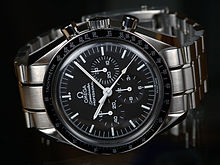 The Omega Speedmaster, selected by U.S. space agencies
The Omega Speedmaster, selected by U.S. space agencies
Zero gravity environment and other extreme conditions encountered by astronauts in space requires the use of specially tested watches. On April 12, 1961, Yuri Gagarin wore a Shturmanskie (a transliteration of Штурманские which actually means "navigator's") wristwatch during his historic first flight into space. The Shturmanskie was manufactured at the First Moscow Factory. Since 1964, the watches of the First Moscow Factory have been marked by the trademark "ПОЛЕТ", transliterated as "POLJOT", which means "flight" in Russian and is a tribute to the many space trips its watches have accomplished. In the late 1970s, Poljot launched a new chrono movement, the 3133. With a 23 jewel movement and manual winding (43 hours), it was a modified Russian version of the Swiss Valjoux 7734 of the early 1970s. Poljot 3133 were taken into space by astronauts from Russia, France, Germany and Ukraine. On the arm of Valeriy Polyakov, a Poljot 3133 chronograph movement-based watch set a space record for the longest space flight in history.[20]
 Astronaut Nancy J. Currie wears the Timex Ironman Triathlon Datalink model 78401 during STS 88.
Astronaut Nancy J. Currie wears the Timex Ironman Triathlon Datalink model 78401 during STS 88.
During the 1960s, a large range of watches were tested for durability and precision under extreme temperature changes and vibrations. The Omega Speedmaster Professional was selected by NASA, the U.S. space agency. Heuer became the first Swiss watch in space thanks to a Heuer Stopwatch, worn by John Glenn in 1962 when he piloted the Friendship 7 on the first manned U.S. orbital mission. The Breitling Navitimer Cosmonaute was designed with a 24-hour analog dial to avoid confusion between AM and PM, which are meaningless in space. It was first worn in space by U.S. astronaut Scott Carpenter on May 24, 1962 in the Aurora 7 mercury capsule.[21] Since 1994 Fortis is the exclusive supplier for manned space missions authorized by the Russian Federal Space Agency. China National Space Administration (CNSA) astronauts wear the Fiyta[22] spacewatches. At BaselWorld, 2008, Seiko announced the creation of the first watch ever designed specifically for a space walk, Spring Drive Spacewalk. Timex Datalink is flight certified by NASA for space missions and is one of the watches qualified by NASA for space travel.Both the Casio G-Shock DW-5600C and 5600E are Flight-Qualified for NASA space travel. [23][24][25][26] The various Datalink models were used both by cosmonauts and astronauts.
Scuba diving
Watches may be crafted to become water resistant. These watches are sometimes called diving watches when they are suitable for scuba diving or saturation diving. The International Organization for Standardization issued a standard for water resistant watches which also prohibits the term "waterproof" to be used with watches, which many countries have adopted.
Water resistance is achieved by the gaskets which forms a watertight seal, used in conjunction with a sealant applied on the case to help keep water out. The material of the case must also be tested in order to pass as water resistant.[27]
None of the tests defined by ISO 2281 for the Water Resistant mark are suitable to qualify a watch for scuba diving. Such watches are designed for everyday life and must be water resistant during exercises such as swimming. They can be worn in different temperature and pressure conditions but are under no circumstances designed for scuba diving.
The standards for diving watches are regulated by the ISO 6425 international standard. The watches are tested in static or still water under 125% of the rated (water)pressure, thus a watch with a 200 metre rating will be water resistant if it is stationary and under 250 metres of static water. The testing of the water resistance is fundamentally different from non-dive watches, because every watch has to be fully tested. Besides water resistance standards to a minimum of 100 metre depth rating ISO 6425 also provides eight minimum requirements for mechanical diver's watches for scuba diving (quartz and digital watches have slightly differing readability requirements). For diver's watches for mixed-gas saturation diving two additional requirements have to be met.
Watches are classified by their degree of water resistance, which roughly translates to the following (1 metre = 3.281 feet):[28]
Water resistance rating Suitability Remarks Water Resistant 30 m or 50 m Suitable for washing hands. 50 m suitable for showering and light swimming. not suitable for swimming or diving.[citation needed] Water Resistant 100 m Suitable for recreational surfing, swimming, snorkeling, sailing and water sports. not suitable for diving. Water Resistant 200 m Suitable for professional marine activity and serious surface water sports. suitable for diving. Diver's 100 m Minimum ISO standard (ISO 6425) for scuba diving at depths not requiring helium gas. Diver's 100 m and 150 m watches are generally old(er) watches. Diver's 200 m or 300 m Suitable for scuba diving at depths not requiring helium gas. Typical ratings for contemporary diver's watches. Diver's 300+ m helium safe Suitable for saturation diving (helium enriched environment). Watches designed for helium mixed-gas diving will have additional markings to point this out. Some watches use bar instead of meters, which may then be multiplied by 10, and then subtracted by 10. This is because 1 bar is equal to one atmosphere or 10 metres of water (therefore 1 bar at the surface and one more each 10 metres). to be approximately equal to the rating based on metres. Therefore, a 5 bar watch is equivalent to a 40 metre watch. Some watches are rated in atmospheres (atm), which are roughly equivalent to bar.
Sport
One of the fastest growing segments of the Watch industry is the "Sport" watch. Made for both function and style these watches often contain extra features like compasses, altimeters, barometers, and thermometers. Some of the higher end sport watches will even have a "heart rate monitor".
See also
- American Watchmakers-Clockmakers Institute
- List of watch manufacturers
- Marine chronometer
- National Association of Watch and Clock Collectors
- Tachymeter
- WatchTime Magazine
References
- ^ a b "The History of Watches". SteelWatch.co. http://steelwatch.co/history-of-watches.php.
- ^ Pulsar LED Smithsonian
- ^ The New Oxford American Dictionary (2nd Ed., eBook edition), Oxford University Press, 2008
- ^ John E. Brozek (January 2004). "The History and Evolution of the Wristwatch". International Watch Magazine. InfoQuest Publishing, Inc.. http://www.qualitytyme.net/pages/rolex_articles/history_of_wristwatch.html.
- ^ "Temperature". Advice on Your Timepiece. Tag Heuer. http://us.tagheuer.com/#/temperature.
- ^ "Magnetism". Advice on Your Timepiece. Tag Heuer. http://us.tagheuer.com/#/magnetism.
- ^ The original pin-pallet
- ^ The Roskopf Watch
- ^ Buffat, Eugene, History and Design of the Roskopf Watch
- ^ "Watchmaking in Europe and China: Watches & Wonders". Richemont. Worldtempus. http://www.worldtempus.com/wt/1/6791/. Retrieved 2007-01-17.[dead link]
- ^ "Milestones:Pioneering Work on the Quartz Electronic Wristwatch, 1962-1967"
- ^ Quartz mechanisms usually have a resonant frequency of 32768 Hz, chosen for ease of use (being 215). Using a simple 15 stage divide-by-two circuit, this is turned into a 1 pulse per second signal responsible for the watch's keeping of time.
- ^ "History of the Solar Wristwatch". Soluhr.com. http://www.soluhr.com/. Retrieved 2007-01-17.
- ^ The Ten Ten Tenet, Snopes.com
- ^ "Why Time Stands Still for Watchmakers". New York Times. 2008-11-28. http://www.nytimes.com/2008/11/28/business/media/28adco.html. Retrieved 2008-11-28.
- ^ "TI $20 Watch", The Jerome and Dorothy Lemelson Center for the Study of Invention and Innovation, Smithsonian Institution
- ^ "Casio TA-1000 Electronic Clock & Calculator". Magical Gadgets, Sightings & Brags. Pocket Calculator Show. http://pocketcalculatorshow.com/magicalgadget/index3.html#teletime. Retrieved 2007-01-17.
- ^ "First-Hand:Liquid Crystal Display Evolution - Swiss Contributions - GHN: IEEE Global History Network". Ieeeghn.org. http://www.ieeeghn.org/wiki/index.php/First-Hand:Liquid_Crystal_Display_Evolution_-_Swiss_Contributions. Retrieved 2011-10-23.
- ^ "Havocscope Counterfeit Watches Market Value: $1 billion". http://www.havocscope.com/counterfeit-watches-market-value/.
- ^ Russian Space Watches History
- ^ "Navitimer, the aviator favourite watch". Breitling. http://www.breitling.com/en/models/navitimer/cosmonaute/. Retrieved 2007-01-17.
- ^ "Fiyta.com.cn". Fiyta. http://www.fiyta.com.cn. Retrieved 2007-01-17.
- ^ "Internet Archive Wayback Machine". Web.archive.org. 2006-11-14. http://web.archive.org/web/20061114025319/http://www.nasaexplores.com/show2_5_8a.php?id=02-024&gl=58. Retrieved 2011-10-23.
- ^ "Internet Archive Wayback Machine". Web.archive.org. 2008-03-04. http://web.archive.org/web/20080304191551/http://www.nasaexplores.com/search_nav_9_12.php?id=02-024&gl=912. Retrieved 2011-10-23.
- ^ Picture of Datalink USB in space
- ^ "The NASA Timex Datalink watches (Pic Intensive)". Forums.watchuseek.com. http://forums.watchuseek.com/showthread.php?t=159191#post1087071. Retrieved 2011-10-23.
- ^ Europa Star Online article "Watch Industry Questions and Answers: Water-Resistance". Europa Star. VNU eMedia Inc. http://www.europastar.com/europastar/watch_tech/waterresistance.jsp Europa Star Online article. Retrieved 2007-01-17.
- ^ This water resistance classification guide has been developed by the Jewellers and Watchmakers of New Zealand (Inc.) in conjunction with the major watch importers and wholesalers in New Zealand.
Further reading
- De Carle, Donald, (Illustrations by E. A. Ayres), Practical Watch Repairing, 3rd edition, New York : Skyhorse Pub., 2008. ISBN 9781602393578
External links
- Sport Watch
- Origins of Waltham Model 57
- Philadelphia Exhibition 1876 Report to the Federal High Council by Ed. Favre-Perret (1877)
- American and Swiss Watchmaking in 1876 by Jacques David
- The Watch Factories of America Past and Present by Henry G. Abbott (1888)
- Watchmaking and the American System of Manufacturing (2009)
- Federation of the Swiss Watch Industry FH
- UK patent GB218487, Improvements relating to wrist watches, 1923 patent resulting from John Harwood's invention of a practical self-winding watch mechanism.
- The Most Expensive Watches
Time measurement and standards Major subjects International standards UTC · UTC offset · UT · ΔT · DUT1 · IERS · ISO 31-1 · ISO 8601 · TAI · 12-hour clock · 24-hour clock · Barycentric Coordinate Time · Civil time · Daylight saving time · Geocentric Coordinate Time · International Date Line · Leap second · Solar time · Terrestrial Time · Time zoneObsolete standards Time in physics Horology Clock · Astrarium · Atomic clock · Complication · Equation of time · History of timekeeping devices · Hourglass · Marine chronometer · Marine sandglass · Radio clock · Sundial · Watch · Water clockCalendar Astronomical · Dominical letter · Epact · Equinox · Gregorian · Hebrew · Intercalation · Islamic · Julian · Leap year · Lunar · Lunisolar · Seven-day week · Solar · Solstice · Tropical year · Weekday determination · Weekday namesArchaeology & geology Astronomical chronology Units of time Related topics
Wikimedia Foundation. 2010.

